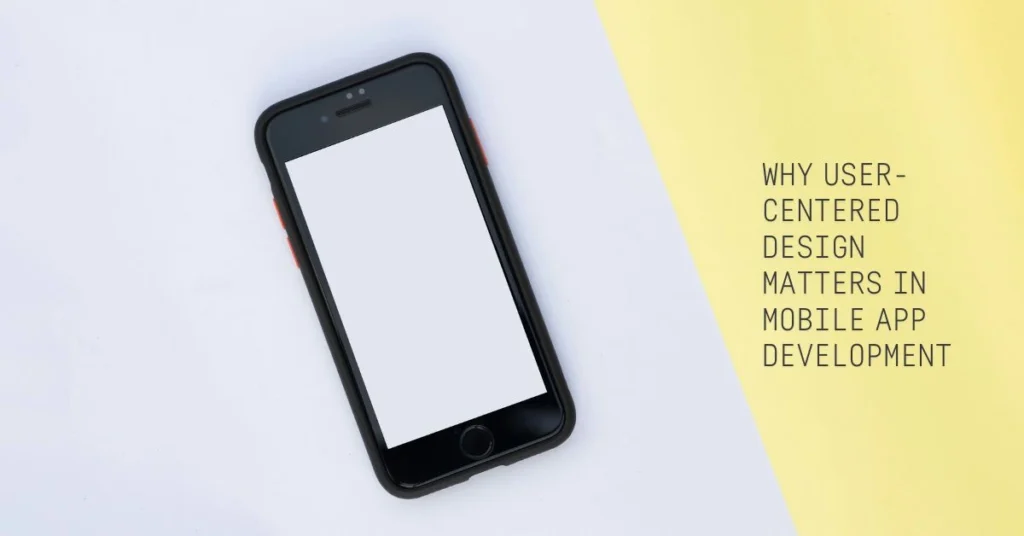In today’s hyper-competitive digital world, building a mobile app is no longer just about writing clean code or creating stunning visuals. Success increasingly depends on how well the app understands and serves its users. That’s exactly why user-centered design matters in mobile app development. When you place users at the core of every design decision, your product not only stands out but also builds lasting trust, engagement, and loyalty.
Recent research from Nielsen Norman Group shows that apps designed with a user-first approach experience up to 200% higher engagement and 30% lower churn rates than those that don’t. These numbers clearly prove a simple truth: designing for users isn’t enough—you need to design with them.
What Is User-Centered Design in Mobile App Development?
The importance of user-centered design becomes clear when you understand the core concept of UCD. Don Norman, the pioneer of user-centered design (UCD), defines it as a framework where real users shape every step of the design process. This approach emphasizes understanding user needs, goals, and challenges before creating a solution. Unlike traditional design, which often starts with business objectives, UCD begins by asking a simple yet powerful question: “What does the user need most?”
In mobile app development, this means going beyond surface-level aesthetics. It’s about making the experience intuitive, accessible, and delightful. From onboarding flows to error handling, every interaction should feel natural to the user.
The Four Core Phases of User-Centered Design
1. Understanding the Context of Use in Mobile Apps
Every successful app starts with empathy. Designers and developers must observe real users, analyze their environment, and uncover pain points. For example, a fitness app might need different interaction patterns for users jogging outdoors versus those working out at home. This illustrates the importance of user-centered design in mobile applications.
Practical steps in this phase:
- Conduct user interviews and surveys
- Create empathy maps and user personas
- Observe users in real-world settings
2. Identifying User Requirements for Better UX
Once the context is clear, the next step is defining what users actually need. This stage often involves translating insights into functional and emotional requirements. For instance, if users struggle with long sign-up processes, simplifying authentication becomes a priority. This is another reason the importance of UCD in app design stands out.
Typical deliverables include:
- Clear user stories
- Prioritized feature lists
- Accessibility requirements
3. Designing Solutions Through User-Centered Design
This is where creativity meets strategy. Designers create wireframes, prototypes, and user flows focused on ease of use. Instead of building a “feature-heavy” product, they craft a user-friendly journey. This phase reflects the true importance of user-centered design in app creation.
Effective practices in this phase:
- Low- and high-fidelity prototyping
- Usability heuristics application
- Early testing on real devices
4. Evaluating and Iterating Continuously
Unlike linear models, UCD thrives on iteration. Continuous testing ensures the product aligns with evolving user needs. A simple usability test can reveal friction points that might have gone unnoticed during development. That’s why focusing on users throughout app design is crucial.
Key methods here include:
- A/B testing
- Usability testing with target users
- Feedback loops and behavior analytics
Why User-Centered Design Matters in Mobile App Development: The Core Benefits
Placing users at the heart of your design process transforms the way your app performs in the real world. When users feel heard, they become loyal advocates. When they find value effortlessly, retention naturally improves. Therefore, understanding the importance of user-centered design in app development gives your app a competitive edge.
Here’s why UCD is a game-changer:
- Higher engagement: A well-designed app keeps users coming back.
- Reduced abandonment: UCD minimizes the risk of confusing interfaces.
- Inclusive experiences: No user is left behind.
- Efficient development cycles: Early testing saves time and cost.
- Stronger brand perception: Trust grows faster with intuitive design.
The Principles That Drive Effective User-Centered Design
1. Prioritizing User Research in Mobile App Development
Every decision should stem from user insights, not assumptions. Interviewing, observing, and understanding user goals allow teams to solve real problems rather than perceived ones. This principle highlights why user-centered design matters in mobile app development.
2. Iterative Design Thinking for Sustainable Apps
Rather than launching a “perfect” app once, UCD promotes continuous refinement. Feedback becomes fuel for innovation, ensuring the app evolves with its audience. As a result, why user-centered design matters in mobile app development is directly linked to long-term growth.
3. Usability and Accessibility for All Users
An app that works for everyone wins more hearts. Accessibility isn’t optional; it’s a core principle. Adding voice controls, proper contrast ratios, and readable typography can significantly broaden your user base. This is another example of why user-centered design matters in mobile app development.
4. Feedback-Driven Improvement
Real users are the best testers. Incorporating feedback loops throughout the process ensures the product always stays relevant, which further explains why user-centered design matters in mobile app development.
UCD vs Traditional Design: A Clear Difference
| User-Centered Design | Traditional Design |
|---|---|
| Starts with user needs | Starts with product goals |
| Involves users throughout | Limited or no user involvement |
| Iterative and adaptive | Linear and rigid |
| High retention & loyalty | Higher abandonment rates |
| Focus on inclusivity | Focus on aesthetics alone |
While traditional design often revolves around internal assumptions, UCD anchors every decision in real user behavior. This difference shows why user-centered design matters in mobile app development from the very beginning.
Real-World Example: How Airbnb Used UCD
Airbnb didn’t just build a platform for bookings; it created a seamless, intuitive journey for both hosts and guests. Through deep user research, the company discovered key pain points such as confusing listing processes and complex search flows. By redesigning these experiences around user behavior, Airbnb boosted conversion rates and built lasting trust with millions of users worldwide. This real case strongly supports why user-centered design matters in mobile app development.
Expert Insights: The Power of User-Centered Design in App Development
“User-centered design isn’t a step in the process—it is the process,” explains Don Norman. His philosophy reinforces why empathy must guide every development stage. Additionally, UX specialists highlight that apps designed with UCD principles can reduce development rework by up to 50%, saving time and money. This proves once again why user-centered design matters in mobile app development.
How to Implement User-Centered Design in Mobile App Development
- Start early: Integrate user research at the concept stage.
- Prototype fast: Validate ideas before writing code.
- Test with real users: Lab, remote, and field testing uncover hidden issues.
- Design for accessibility: Make your app usable by everyone.
- Iterate continuously: Treat launch as the beginning, not the end.
Common Mistakes to Avoid in User-Centered Design
- Skipping early user research
- Overcomplicating navigation
- Ignoring accessibility standards
- Testing too late in the cycle
- Treating UCD as a one-time activity
Avoiding these mistakes emphasizes once again why user-centered design matters in mobile app development.
Business Benefits: Why User-Centered Design Matters for App Success
Adopting a user-centered approach isn’t just good for users—it’s a powerful business strategy. According to industry data, apps with excellent usability enjoy 3× higher retention rates. Additionally, companies that prioritize UX outperform the S&P 500 index by more than 200%. This is clear evidence of why user-centered design matters in mobile app development for business growth.
Key business advantages:
- Better ROI and lower development costs
- Stronger customer loyalty and advocacy
- Increased conversion rates and engagement
- Reduced support and maintenance costs
FAQs About Why User-Centered Design Matters in Mobile App Development
1. What is the main goal of user-centered design?
The main goal is to create products that align with user needs, making them easy, accessible, and enjoyable to use.
2. How does UCD improve mobile app engagement?
By simplifying user flows and removing friction points, UCD encourages users to stay longer and interact more frequently.
3. Who introduced the concept of UCD?
Don Norman introduced UCD as a formal concept, emphasizing empathy and human behavior in design.
4. Is UCD different from design thinking?
Yes, design thinking is a broader innovation framework, while UCD focuses specifically on involving users throughout the design process.
5. How can startups implement UCD effectively?
Start small by conducting user interviews, creating prototypes, and testing with a few users. Over time, scale your UX process with structured testing and feedback loops.
Final Thoughts
Understanding why user-centered design matters in mobile app development isn’t just an academic exercise—it’s a competitive advantage. When your app listens to users, adapts to their needs, and delights them at every step, it becomes more than a tool; it becomes a trusted companion.
Start by empathizing, iterating, and testing early. A well-designed user experience can transform an ordinary app into an unforgettable one. Remember, your users are the best designers you’ll ever have.
Want to explore more UX insights? Check out our UI/UX Design and App Development categories for in-depth guides and real-world strategies.


